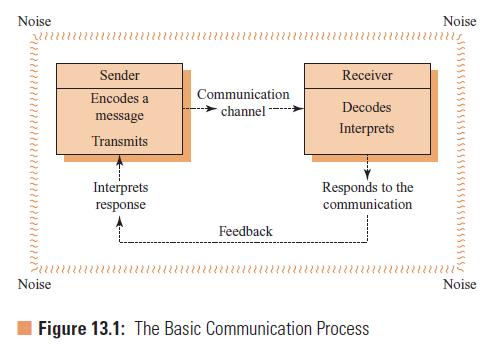Review the Dysfunctions of Organizational Communication section. Have you experienced any of those dysfunctions during your college
Question:
Review the “Dysfunctions of Organizational Communication” section. Have you experienced any of those dysfunctions during your college education? Reflect on your work experiences. Discuss examples of communication dysfunction from those experiences.
Dysfunctions of Organizational Communication
Figure 13.1 showed the basic model of communication surrounded by noise. Noise includes all forms of error that can happen during communication. Errors can come from the sender, the receiver, the message, and the medium of communication. Such noise or errors lead to dysfunctions of organizational communication.
Selective perception lets receivers block out information they do not want to hear in a message. Receivers might block out threatening information or information that disagrees with their beliefs. They might also block some information to reduce the amount they need to process. Despite the sender’s intended meaning, the receiver “selectively listens” to the communication. The receiver then uses the perceived information in the message to develop his meaning of it. Selective perception can also affect the information the sender gets from the receiver about the receiver’s interpretation of the sender’s message. The sender’s assessment of the accuracy of the receiver’s interpretation can affect the sender’s reaction to the receiver. For example, the sender might repeat the message several times if he believes the receiver did not understand it correctly.
Semantic problems are communication dysfunctions that occur when the receiver’s interpretation of a message differs from the sender’s intended message. Some words have different meanings for different people. For example, words or phrases such as good, average, and do your best can have widely varying interpretations. Such words often are at the center of semantic problems in oral and written performance appraisals. Other semantic problems stem from the jargon used by professional or technical groups and the in-group language of different functional groups in an organization. Accountants talk about “burden,” manufacturing engineers discuss “metrology,” computer specialists worry about “upload and download,” and Harry Potter fans chant “Expecto patronum, expecto patronum” just before a major business presentation. Further semantic problems come from the international context of globally operating firms. One case study of five Russian companies with Western participation showed the immense difficulties in communication because of different meanings given to words. For example, the concept of feedback in an organization meant “top-down control” to the Russian managers and “continuous involvement of employees” to their Western counterparts.
Message distortion can occur when the sender and receiver do not have the same frame of reference. We all have had different experiences that give different meanings to our present experiences. The attributes, background, organizational position, and culture of the sender and receiver might differ, causing them to interpret messages differently. Receivers can distort messages by making assumptions about the sender and what his message means. Such assumptions can cause the receiver to begin decoding and taking action before hearing the entire message. Both the meaning and the action might not be what the sender intended.
Senders can filter (subtract from) the content of a message either intentionally or unintentionally. Message filtration reduces a message’s information content, possibly leading to misinterpretation by the receiver. The sender might intentionally filter a message because of fear of the receiver’s reaction. The sender might unintentionally filter a message if he does not understand the problem or issue he wants to communicate. Both types of message filtration produce messages without enough information to let the receiver interpret them accurately.
Step by Step Answer:

Organizational Behavior Integrating Individuals Groups And Organizations
ISBN: 9780415804646
4th Edition
Authors: Joseph E. Champoux





